Why the Arts Matter
By Lisa WeselThe creation and appreciation of art is universal across continents, cultures and classes, and at the same time is intensely personal. But does that make it worth studying, worth funding, worth doing? Does art matter?
These questions arise in conversations among politicians, philanthropists and educators, and while they often are not asked that openly, they are answered nonetheless with the decisions we make and the direction we take as a society.
At Bowdoin, the questions have been asked - and discussed at length - and the answer quite simply is "yes."
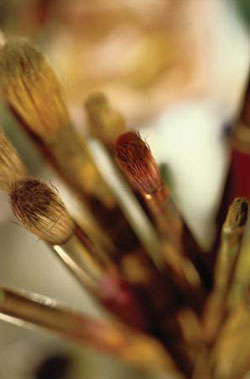
Art is alive on campus, from the music escaping through doors and windows of Gibson Hall to the exhibits of student art in the "fishbowl" of the Visual Arts Center. Posters and bulletins adorn walls and doors across campus advertising performances of every ilk and seeking new members for yet another musical or dance group. Theater auditions and performances are packed. Students who are talented enough to attend art colleges and music conservatories are choosing to come to Bowdoin instead, and students who've never picked up a paintbrush or a script are enrolling in visual arts and performance classes, sometimes unleashing enormous hidden talent. Faculty from all disciplines are incorporating art in their courses as never before, and for the first time in Bowdoin history, students will be required to take at least one course in the arts before graduating.
The College is continuing to make a substantial investment in arts infrastructure, from the completed reconstruction and expansion of Memorial Hall and the renovation of the Chapel, to renovation of the Walker Art Building beginning this summer and the proposed construction of a concert hall in the Curtis Pool building.
“The arts bring energy and creativity, a kind of learning that can only enhance every other kind of learning. The enterprise of a liberal arts education is integrative, to educate students to be creative and flexible, to harness their energy in a different way.”
—June Vail, professor of dance and the founder of Bowdoin's dance program
“The history of civilization is written in art. For a people to be civilized, they need to understand their history.”
—Peter Simmons '78 executive director of the Bowdoin International Music Festival
A Little Art History
Bowdoin's connection to the arts had auspicious beginnings. In 1811, James Bowdoin III bequeathed his substantial art holdings to Bowdoin, creating the country's first collegiate collection of European paintings, prints and drawings. The Bowdoin family added its considerable portrait collection in 1826. The Walker Art Building opened in 1894, one of the first college art museum buildings in the country. And some of the College's most enduring traditions are artistic ones: The student dramatic group, Masque and Gown, was founded in 1903, and has sponsored a student-written one-act playwriting contest for more than 70 years; and the male a cappella group, the Meddiebempsters, has been around since 1937.
Despite that, the arts had almost no role in the curriculum in the College's early history. Other than teaching students how to render images for scientific purposes, Bowdoin didn't offer classes in the arts until 1913, and those were limited to art and music history with a little musical performance. The creation of art for art's sake was considered a nicety, a cultural and social pursuit not appropriate for serious higher education.
"The arts struggled to gain a foothold in academia," said Clifton Olds, Edith Cleaves Barry Professor of the History and Criticism of Art, Emeritus. "The teaching of art history didn't take hold in this country until the turn of the 20th century, and that was only because it has the advantage of being 'historical.'"
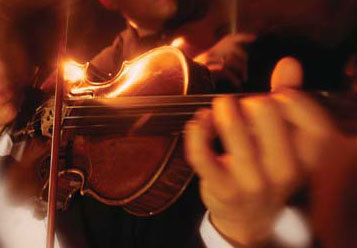
The tide truly began to turn in the 1970s with two seemingly unrelated events: First, traditional all-male colleges like Bowdoin began admitting women. Later in the 1970s and into the 1980s, the emergence of cognitive psychology helped to validate the intellectual importance of the arts.
"It was only in maybe the past 30 years that men in coed liberal arts colleges have begun taking studio art classes in great numbers," Olds said.
The same is true of the performance of music, particularly instrumental music.
"Gibson Hall [built in 1954] was designed around an amphitheater for the glee club," explained Elliott Schwartz, Robert K. Beckwith Professor of Music, Emeritus, who taught at Bowdoin from 1964 to 2002. "There were no lockers for instruments. The only instrumental music on campus was the ROTC band and a small football band. I was the first faculty member not interested in voice."
"Bowdoin is similar to other New England formerly all-male colleges in that it was very suspicious of the arts as a creative exercise," Schwartz said.
"It started with the distrust by the Puritans of all the arts as the practices of libertines," Helen Vendler, poetry critic and the A. Kingsley Porter university professor at Harvard University, explained in an interview in the Jan. 28, 2005, issue of the Chronicle of Higher Education. "We had to forge a new nation, build it moving westward, which always meant that a practical education was more highly valued than an aesthetic education."
When liberal arts colleges began recovering from Puritanism, they continued suffering from sexism, believing that "the arts were something that girls did," Schwartz said.
In fact, Vail said she was hired to teach classes in dance when Bowdoin became co-ed in 1971, because "they decided they needed to do something for the women. Art and music were frills on the fringe; cultivated men should know something about them, but not for academic credit. Dance was the most on the fringe."
"There had been a mistaken belief, a myth, that students with a strong interest in the arts belonged in conservatories," Schwartz said. "There was a violent change in the 1970s. Richard Moll, the admissions director, went out of his way to bring artistically inclined students to Bowdoin."
"In the past, students would decide to major in art only after they got here," said Mark Wethli, A. LeRoy Greason Professor of Art, who has taught at Bowdoin for 20 years. "Now we attract people who arrive here wanting to major in art."
The change is visible not only in the curriculum, but in the artistic vitality on campus.
"In the early '60s, there were maybe three or four performances a year by visiting musicians," Schwartz said. "In 1964, we got a grant for a series of eight concerts, and it grew from there."
Now the College schedules nearly 1,000 performances a year of Bowdoin students, community members and world-renowned performers. They include every genre of instrumental and vocal music, dance and theater.
Extra-curricular groups organized by students offer many forms of expression for hundreds of participants. The Meddiebempsters have been joined by other a capella groups - B.O.C.A. and Ursus Verses, which are coed, and the all-female Miscellania - and the Polar Jazz Big Band, Taiko Drummers and the World Music Ensemble. Actors have Masque and Gown, and dance enthusiasts have their own clubs: Arabesque, for advanced ballet; Obvious, for hip-hop and breakdancing; VAGUE, for student-choreographed dance pieces, and the Unity Step Team. Within the curriculum are a half-dozen chamber ensembles, a chamber choir, chorus, concert band and small jazz ensembles.
"A lot of students here do arts," noted Diego Milan '08, who is majoring in English with a music minor. "I see so many instruments running around. There are so many ensembles, so many different music groups."
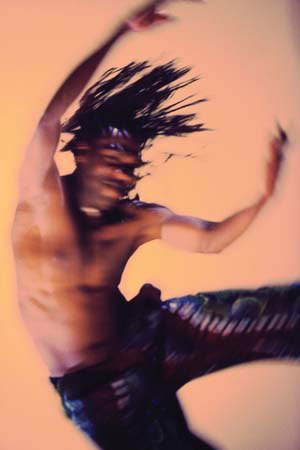
Why the Arts?
Art is important in society for innumerable reasons. It communicates across barriers of language, class and culture. It elicits a visceral reaction when words alone often cannot. And it reflects the collective psyche of a generation, when it is not actually helping to shape it.
"Just think of the Gates Project," said Kimberly Powell, senior research associate and instructor of education and art education at Penn State University. "The last time New York City looked up at the sky collectively was on 9/11. This time, it's about beauty. People were smiling and crying at the exhibit. Words often fail us. Numbers fail us. We need to be literate in these other forms of expression."
"Beauty is an important part of life," added Mary Hunter, A. LeRoy Greason Professor of Music. "It accesses part of your mind and psyche that other types of media don't necessarily, and they're important parts of you. It's not just self-indulgent escapism. I think it's necessary to remove ourselves from flat-footed literalness."
"Art is another human being's attempt to make sense of the world," said Katy Kline, director of the Bowdoin Museum of Art. "It's immediate. We live in a virtual world now. We have access to a great deal of information and very little real experience. The pleasure people take in art - their response - is in itself a meaningful event."
"Art is not an elective; it's an essential part of the human spirit," said Professor Johanna Keller, director of the new Goldring Arts Journalism Program at Syracuse University's S.I. Newhouse School of Public Communications, the only master's degree program for arts writers. "What was the first thing cave dwellers did when they became 'human?' They started making art on cave walls. They started making drums. Art is not a luxury; it was a necessity right off the bat."
“Without nurturing creativity, you don't get the ability to leap from facts to the future; from information to what you do with that information.”
—Peter Simmons '78
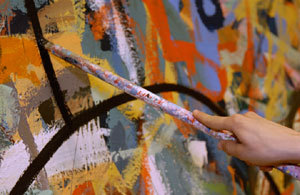
Creating art is also an important intellectual exercise. Howard Gardner, Hobbs Professor of Cognition and Education at Harvard's Graduate School of Education, outlined his theory of "Multiple Intelligences" in his 1983 book, "Frames of Mind." In it, he argues that human intelligence is not limited by the standard measures of mathematical and linguistic ability. Of equal importance are, among others, musical intelligence; the spatial intelligence exhibited by visual artists and architects, and the bodily/kinesthetic intelligence of dancers, actors, athletes and surgeons.
"Cognition is not just about reasoning through word or number," Powell wrote in an article about the use of art in science published in the summer 2002 issue of the journal "Curriculum Inquiry." "It is about using one's sense and the sensuous qualities of materials to think within a medium, of physically engaging with the world, in order to reason."
Powell, along with Elliott Eisner, curriculum theorist and art educator at Stanford University, interviewed 30 social scientists and discovered that they invoke many "artistic" methods in their scientific work. One likened the process of formulating a study to the process of creating music. Another said the artistry in science consists of "the seeing of patterns and linking the pieces and pulling together all that different stuff to make sense of it."
Gaining Insight Through Art
When students arrive at the studio during the fourth week of Mark Wethli's Drawing I class, they find an indecipherably blurry image projected on the wall; they are told to pick up a charcoal stick and draw exactly what they see.
"Don't stress about what you are drawing or what it might become," Wethli tells them. Every 15 minutes, he sharpens the focus ever-so-slightly, and tells them to keep drawing. Not until the last 15 minutes of the 2-hour class does the clear image emerge: a black and white photo of the head of a common dog. It is upside down. By then, many students are so absorbed in the exercise, they still don't recognize the animal.
Wethli is trying to make his students pay attention to the forms, the shades, the structure of the image. If they'd known it was a dog, their mind's eye would be tainted by the memory of every dog they had seen, and their drawing would be influenced by their preconceived notion of what a dog looks like. He is teaching his students to see.
"It's difficult to see beyond the surface," Wethli explained, "especially when surface appearances hold such strong symbolic and emotional value. This is just one of the exercises we use to help students perceive and analyze form in a more objective and comprehensive way."
By all accounts, this exercise works.
"Art makes you more observant of the world in important ways," said Rachel Coulter '04, a former student of Wethli's who initially intended to major in neuroscience but graduated with a bachelor's in English. "Art makes you pick the world apart, take all the pieces and figure out how they work together. It's the same reason I like science."
"You're solving a visual problem in the same way you'd work out a chemical formula," said Alex Smith '06, a biology/pre-med major who plans to be a surgeon. "My way of studying is very visual. I recopy diagrams; I rewrite things."
Wethli said a history student of his had written in an essay that, while studying drawing, he had discovered a similarity between writing history and drawing an image: Many people may observe the same event or object but interpret it in very different ways.
"While the uncertainties of perception, and the question of whether there can ever be such a thing as an objective point of view, are addressed theoretically in physics, philosophy, psychology, sociology and anthropology, in the arts, students confront these questions first-hand, questioning their own sense and negotiating more subtle solutions every time they go to work," Wethli said in a lecture he gave at the St. Paul's School in Concord, N.H., in January 2001.
"Making art increases their skepticism in the best sense of the word," he said. "It's an important step forward in one's intellectual life."
"When you open room for ambiguity, you open room for critique," Powell added. "When you shut down the arts, you shut down the domain for multiple meanings."
“Art forces students to navigate the complex terrain between intellect and feeling, between mind and heart. It's risky business.”
—Matt Klingle, assistant professor of history and environmental studies
Using Art in Other Disciplines
Bowdoin's art collection is remarkable for a such a small college. What is even more unusual is the extent to which it is used by professors who teach everything but art.
At the beginning of the year, all faculty receive a memo from the museum' curatorial intern offering the museum and its contents for use in their classes. The intern will work with faculty to pull together pieces of artwork that are relevant to a particular course, then give a talk to the class in a seminar room surrounded by the artwork. Some faculty have created entire gallery exhibitions based on a course. Students also can gain access to pieces from the collection for independent research.
"People react strongly to art," said Kate Westley, the museum's Andrew Mellon Curatorial Intern. "It's important to have something like that to trigger thought about things bigger than your own life. Even art you don't like makes you think."
"Bowdoin is blessed to have a renowned art museum that is open to faculty and students," said Matt Klingle, assistant professor of history and environmental studies. "Art provides one of the most compelling windows into the relationship between human beings and nature through time. It helps them view nature as a resource, as a contemplative retreat, something endangered and in need of protection. It's one thing to lecture about the Hudson River School or Winslow Homer; to see the physical object is something totally different."
The images he shows them can be jarring. In an environmental studies course, "Nature, Culture, and Human Experience," students witnessed the human influence on nature, which is sometimes obvious, and sometimes quite subtle.
Mark Klett's 1990 photograph, "Cul de sacs: Failed Development West of Phoenix, 'Estrella,'" shows a landscaped scarred by a series of cul de sacs carved into the ground like crop circles, then abandoned.
Frank Gohlke's 1979 photograph, "Tallow Spill, Near Levec, California," shows a river of tallow that could easily be mistaken for a bucolic landscape. It looks quite different when students learn that it is actually waste from a tannery.
Klingle also confronts them with Ansel Adams' familiar and unthreatening photograph of Mt. McKinley.
"But the national parks were created by expelling the native people," Klingle said. "The photo is a partial truth, which obscures a more painful truth. Students are used to calendar art. Getting them to think about art as a historical document forces them to slow down and contemplate what they are seeing."
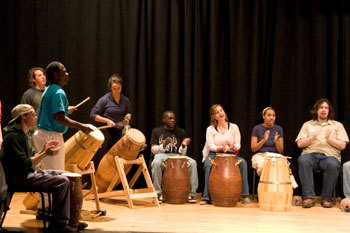
William Watterson, Edward Little Professor of the English Language and Literature, shows his students from the first-year seminar on Hawthorne a miniature portrait of William Allen, Bowdoin's third president, painted by Edward Malbone. The tiny portrait is similar to those described in "The House of Seven Gables."
"Suddenly, Edward Malbone is a real person," Watterson said.
Dorothea Herreiner, assistant professor of economics, has seen her students moved by artwork in a way they might not have been by text alone. Students in Economics 248, "Money: From Gold to Paper to Bytes," are shown images of the many ways people earn money, from the heartbreaking Daumier lithograph of a man forced to pawn his last possessions in order to survive, to Nicolaes Claes Cornelisz Moeyaert's "Joseph Sold by His Brothers," depicting the wretched greed that drives people to sell other human beings.
"Art is very good at provoking you, making you look at what we're doing and how we're living. It's part of the canon of what you should learn, a tool you could use later in life," she said.
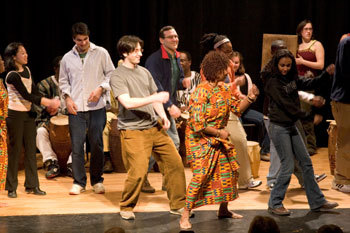
"I'd like to have the art museum give us (an exhibit of) artworks that were talked about being banned, or were objected to," said Chris Potholm, DeAlva Stanwood Alexander Professor of Government. "When we're talking about setting community standards, it makes a big difference to see it in its original."
"It has become one of the most enjoyable and stimulating classes of the year," he said. "The next week, that's all they want to talk about."
Bowdoin is committed to the belief that all students should acquire some level of art literacy, either by creating art, or by studying its history and criticism. So beginning with students who enroll in 2006, all students will be required to take at least one arts class before graduating. It is the first time the College has included the arts among its core requirements separate from the other humanities.
"Aesthetic experience is fundamental to living a rich life," said Craig McEwen, dean for academic affairs. "Not all students are comfortable with it or acquainted with it."
"It shocks me that students can get through four years at Bowdoin and never make it to our side of the buffet," said John Bisbee, Bowdoin art lecturer, who teaches sculpture.
"A liberally educated person should be able to step into the lab and the art museum and knit them all together," Potholm said.
"Kids going into college now will most certainly see a four-day work week, will live well past 100, will be affluent to very wealthy," Watterson said. "They will live lives of cultivated leisure. When you settle into a career, a lot of your reading time goes into the job. If you haven't studied music, painting, art, you aren't likely to acquire these tastes later in life."
"I think of music - and the arts in general - as a language that doesn't communicate actions and things specifically," said Tim Kantor '07. "It's a language that speaks directly to emotion, and it can be much more powerful because of that. An education without an understanding of that language leaves out an important form of expression."
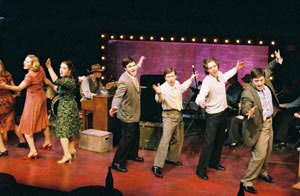
Building a Future in the Arts
In the past 10 years, Bowdoin has committed nearly $50 million to upgrade its arts facilities in an attempt to address the distinct needs of the visual arts, theater and instrumental and vocal music. In June, the Walker Art Building will close for more than two years for a $20 million renovation, including the installation of handicapped accessibility and climate control, which is essential not only for the staff and visitors but for the works of art. Currently, only one storage area for the works on paper is climate controlled, which hampers the museum's ability to borrow individual objects or host traveling exhibits.
With each investment, the College draws a higher caliber of arts faculty and students, and now attracts students talented enough to enroll in conservatories.
"I didn't want to go to an acting conservatory," said Sam Cohan '05, whose experience includes studying with the Royal Shakespeare Company in England and the New England Theater Conference, and working with the Commonwealth Shakespeare Company in Boston. "I didn't want to be just a theater person. A liberal arts education gives me the ability to drawn upon different forms of knowledge."
"When I visited Bowdoin, the year after the new theater opened, I talked to Davis Robinson, (associate professor of theater)," Cohan said. "Of all the college theater directors, he was the most excited about where the department was going, with more people, more classes, the new theater."
Memorial Hall was gutted to the granite walls more than five years ago to reconfigure the 610-seat Pickard Theater, add the new 150-seat experimental Wish Theater, and outfit the entire building with air conditioning and handicapped access. The building houses not only the Bowdoin Department of Theater and Dance, but also has been home to the independent Maine State Music Theatre for the past 40 years.
Kantor, like Cohan, wanted more from his undergraduate education than the art that sustains him. He has been a musician just about as long as he can remember. His father is a violinist, his mother a pianist; both teach at the Cleveland Institute of Music.
"I didn't want to do the conservatory thing," he said, though Hunter said he's a good enough violinist for conservatory training. "I wanted to get a sense of the other mysteries of the world, to get a general education before I got a more specific education."
Kantor chose Bowdoin after visiting the campus and meeting Hunter. Unfortunately, he might graduate before the College finishes building a suitable performance venue for instrumental music.
The College plans to build a $15 million, 300-seat concert hall in the old Curtis Pool building, complete with rehearsal space and practice rooms. Most large performances now take place in Kresge Auditorium, which seats 300 but has acoustics designed for lectures, not music. Pickard and Wish theaters also are inappropriate for instrumental or vocal music. And while the Chapel, which was renovated on the inside in 1998, is exceptional for choral works, it is not appropriate for instrumental performances other than its own organ. The new concert hall will be designed specifically with acoustics that muffle the spoken word but augment the instrumental voice.
All of these projects help to invigorate the arts community on campus and elevate the stature of the College as a whole.
"I heard on the radio once someone talking about the idea of looking at what a culture values by looking at what public buildings and spaces are being created," Robinson said. "Right now, the biggest buildings are malls, office towers, sports complexes, and convention centers. Thank goodness Bowdoin has chosen to put resources into our theaters, and the renovations of the art museum and the future music building. It speaks to the future, if there's going to be one, in a positive and life-embracing way."
At press time, the College learned, with great pleasure and gratitude, that it had secured lead gifts for the concert hall. Further details will be shared as they become available.
This story first appeared in a 2005 issue of Bowdoin Magazine. Browse newer issues of the magazine, or learn more about the arts at Bowdoin.